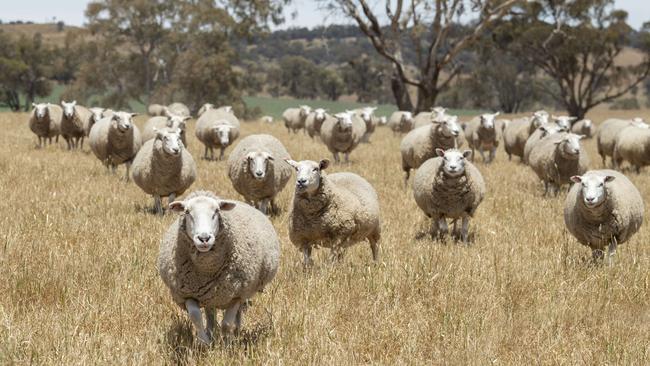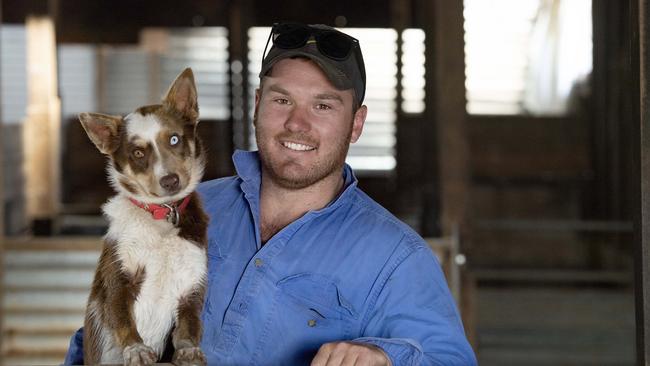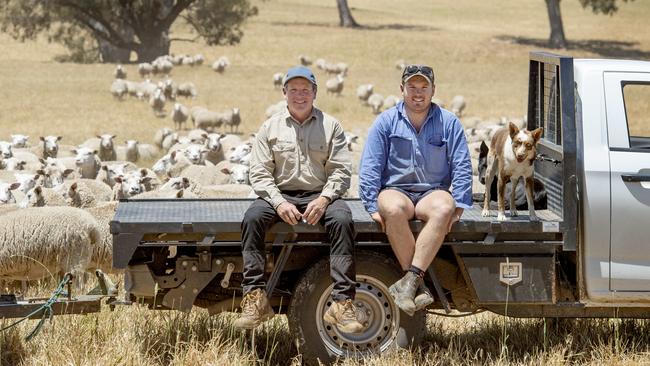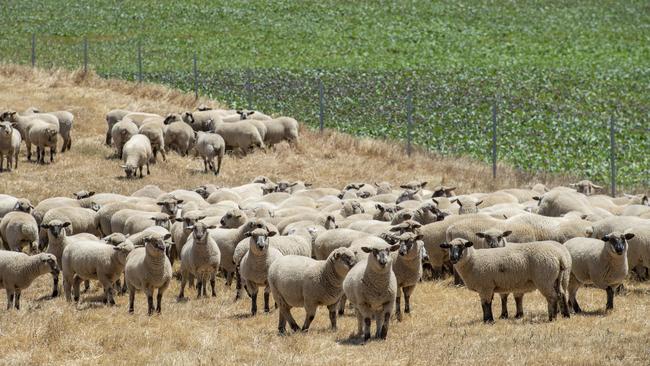Howell Pastoral: How Primeline flock delivers lamb with perfect marbling
Investing in Primeline genetics has transformed productivity and profits for the Howell family’s prime lamb enterprise in western Victoria.
It’s one thing to learn on the job.
But it’s a different – and much more impressive – thing to make a job out of continually learning.
The latter is exactly what the Howell family has done to build their thriving prime lamb enterprise that turns off more than 8700 lambs a year, supplying exceptionally well marbled meat to a farmer-founded export company that is introducing the best Australian lamb to the world.
Scott and Liz Howell, son Daniel, and Scott’s parents, Terry and Rhonda, run 6200 Primeline ewes on 1330ha at Amphitheatre in Pyrenees Shire, northwest of Ballarat.

“My philosophy on things is pretty simple,” Scott says. “We’ve got about half a dozen good people in different areas that we listen to, and we take advice and we’re willing to try advice.
“As soon as you start taking advice, you change things and it becomes exciting, you start to make gains and the next generation will want to come home. It’s about being willing to accept advice, and being willing to change.”
Scott’s enthusiasm for change has definitely generated excitement, and inspired 24-year-old Daniel, who has been farming alongside his dad for the past six years.
Adjusting breeding, feeding, soil inputs and even land use, the pair has made changes to nearly every element of the enterprise, always searching for ways to improve efficiency, productivity and profitability of their flock, and keep things interesting.
Those many small tweaks have delivered a huge leap in lamb quality, consistency and returns, and earned them kudos as a top supplier to Endeavour Meats, an up-and-coming red meat exporter that sells premium products into 30 international markets.

FROM THE GROUND UP
Howell Pastoral was a modest 200ha operation when Scott’s father, Terry, first took the helm in 1970. Over the years the family expanded, buying blocks across the region.
At the age of 30, Scott stepped up to take more responsibility after Terry had a heart health scare. Today Scott works closely with Daniel, while Terry and Rhonda are still involved.
About 15 years ago, tired of being at the mercy of commodity prices, the Howells started looking for more lucrative markets for their lamb.
At the time, Holbrook seedstock producer Tom Bull of Lambpro was refining his Primeline sheep breed, selecting genetics for early lamb growth, moderate ewe weight, fertility, lamb survival, moderate fat and high marbling and eye muscle.
The result is an animal that produces mild, sweet tasting meat with high intramuscular fat – known as marbling – which directly contributes to flavour, tenderness and juiciness.
Excited by Lambpro’s goals, Scott bought four rams from Tom in about 2005, and started putting them over their first-cross Merino-Border Leicester ewes. Over two generations of breeding, the Howells’ flock evolved to now produce lambs with excellent feed conversion traits and consistent marbling of 6 per cent-plus.
“We wished we’d bought some Lambpro ewes at the time, just to start the process quicker, we were just dabbling our feet in it,” Scott said.
Two years ago, the Howells started supplying Endeavour Meats, with their lamb marketed under the Willow Bend brand ending up in top kitchens, high-end restaurants and retail outlets in Australia and the US, commanding a premium that flows back through the farm gate.
“This marketing opportunity is something that I think is fantastic,” Scott said. “Normally you’d send the lambs off to Ballarat (saleyards) and that’s the last you’d see of them.
“With this we’re getting feedback, we’re getting flexibility. If we say we’re going to supply them a load on a date and they’re not quite ready, there is flexibility.
“We are getting a premium for them, too.”
Endeavour takes their grain-finished Primeline lambs at 28-36kg, at about six to eight months of age. The exporter is also finetuning a system to measure intramuscular fat in lamb, and plans to offer a premium based on marbling score.

BREED AND FEED
Lupins are one of many secret ingredients in the Howells’ recipe for well-marbled lamb.
To maximise reproduction rates, ewes are fed lupins starting in late December, for two weeks before and two weeks after joining. Rams also receive lupins six weeks before joining.
Known to stimulate ovulation, the legume contains proteins that improve sperm quality and boost the likelihood of conceiving twins.
Teaser rams go in with ewes for two weeks before fertile rams are introduced on January 1. Joining runs for 23-24 days, with conception rates of 86-92 per cent after the first joining.
Rams then come out for two to three weeks before going back in for a second joining, after which just 1-2 per cent of ewes remain dry.
Two-year-olds are joined on January 25, and ewe lambs on March 1 for seven weeks.
After being flushed with lupins for joining, ewes return to paddocks to graze residue for about 100 days.
Scott and Daniel use pregnancy scanning to identify ewes carrying singles and twins, and then separate them during the final trimester – for about 50 days – to feed extra barley to those carrying twins if needed.
“We haven’t had to do that for the past few years because we’ve had such good breaks,” Scott said.

The Howells always hope for a mild start to winter, as lambing starts June 1. In most years they have achieved lamb survival rates of 150 per cent. Phalaris paddocks are reserved for lambing, while finishing paddocks are base rye-grass and clover, and plantain and clover.
Weaned at 12 weeks of age, lambs spend their final 40 days on an all-grain diet, bought from Farmgate Stockfeeds at Terang. This grain is another critical ingredient that delivers the unique taste and texture sought by Endeavour Meats and its customers who are willing to pay a premium for quality.
“You’ve got to have the right genetics there for a start,” Scott said.
Daniel added: “The feed allows the genetics to come through.”
Scott continued: “The grain does a couple of things in the diet.
“It is good for marbling, but it also takes the strong taste and smell out of lamb. People in other countries that haven’t had lamb before, or have had a bit of lamb and don’t like it because of the strong smell … (Endeavour Meats) tells them, ‘yes, but you’ve gotta try this’. And because of the milder taste and flavour, they love it.
“(Lambs) have to be off brassicas and canola for at least the last eight weeks because that puts a strong taste in it, too.”
Before weaning, lambs are familiarised with a grain diet, receiving six imprint feeds.
Lambs are processed by Cedar Meats at Brooklyn.
In addition to Primelines, the Howells have introduced Hampshire Downs to the mix this year, recently buying 12 rams from Lambpro for next year’s joining.
Of this year’s 8700 lambs, about 1500 are Hampshires, which are turned off a few kilograms heavier than the Primelines and supply the Kinross Station brand marketed by Endeavour Meats.
GRAND LAND PLANS
The Howells have also invested in land to make their stock expansion plans possible, with the goal to build to 7000 ewes in the coming few years.
In 2011, Scott and Liz snapped up 1090ha near their home block, selling off about 450ha of their other properties to make the purchase possible.
With average annual rainfall of 540mm and granite loam soils, the property is good grazing country and means they don’t have to travel between farms to manage stock. But they had a huge task to put in laneways, install fencing, sow paddocks, sink a second bore and put in a gravity-fed water trough system.
The biggest job, and investment, by far has been converting about 640ha of blue gum timber plantations back to productive pasture. The final 200ha is in the process of being levelled and then sowed.
Paddocks are eight to 18ha in size, and soil benefits from applications of potassium and phosphorous fertiliser.
Over the past two years, however, they have tried using chicken manure instead of P and K.
“We’ve grown a lot of feed from that,” Scott said. “It has helped the perennials and the clover.”

Daniel, Scott and Liz have worked side-by-side on most of the improvements, with Daniel introducing more precision technology, from a hi-tech sprayer and seeder to electronically monitored sheep feeders.
Scott said their approach to producing lamb had matured and improved over the past 30 years, since he and former chef Liz first met.
“As far as breeding lamb, we’ve done that pretty much ever since I’ve known Liz, but the way we do it now is no comparison to what it was back then,” Scott said.
“But sheep have changed so much in that time too. And markets, and exports. Everything has grown up.”
Daniel has also led the family’s effort to become certified with Global Animal Partnership, a third-party animal welfare accreditation program.
“Most of it is things you should be doing already,” Daniel said. “(Not) mulesing is the biggest one.”
He said the biggest change he had to make to gain accreditation was to tighten up their record-keeping, to document husbandry practices.
In the next five years their biggest focuses will be improving efficiencies and starting to transition to shedding sheep.
“Shearing takes two people six weeks, for nothing,” Scott said. “The wool covers the cost of the shearing, but that’s it.”
So, a move to shedding Primeline genetics would pay off in more ways than one, especially as Tom Bull perfects the breed so there is little trade off in lost production.
“Everything has just fallen into place with this farm … the time we bought the ground coincided with Daniel leaving school,” Scott said.
“Ever since he’s been home, we’ve been flat out.”
Their commitment to continual learning – from each other, from professional advisers, and from other farmers such as Tom Bull – has also extended to participation in industry and community programs such as Best Wool, Best Lamb.
“We have learnt a lot from the course. It’s something I think is very important for anyone,” Scott said. “That was the start of our knowledge.
“Everyone’s got something they’re doing well, and everyone’s got an issue they should be dealing with.
“If they spoke to their neighbour they might be able to fix it. Communication is as big as anything, and being willing to share mistakes and successes.”




